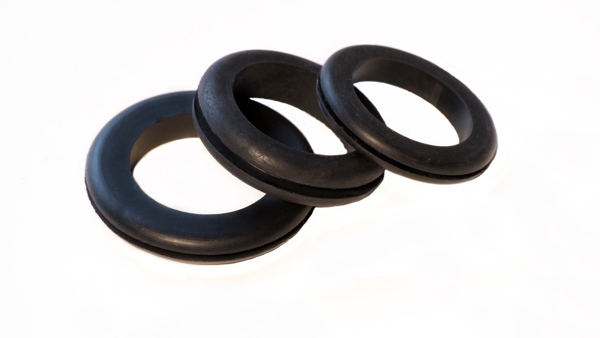
Proper parts play a pivotal role in the success of your HVAC units. The right rubber through wall grommets protect wires, tubes, and lines from sharp edges. Of course, there are a variety of factors that impact which parts are perfect for your applications. Let’s break down the different design and performance needs that dictate which through wall grommets are best for your units.
Through Wall Grommets Design Considerations
Identifying the right through wall grommets depends on your HVAC unit’s specific design needs. Multiple factors play a key role in the success of your grommets.
- Sheet metal thickness
- Size and shape of the opening
- Size and number of items going through the grommet
- Airtight qualities
- Desired aesthetics
- Flexibility for different openings
Factors like sheet metal thickness and the size and shape of the opening are more straightforward – you’ll need to ensure that your grommets are made to fit around your openings without being too loose or too tight. Simply put, the part needs to fit to work.
You’ll also need to weigh what will run through your grommet and if the grommet needs to serve as some form of barrier. For example, do you need to create an airtight seal or can air freely pass through the part? Some grommets feature a webbed inside diameter that can expand to shut out dust, debris, and other unwanted elements without constricting too much.
Aesthetics are another potential design concern for through wall grommets. If the grommet is visible to the consumer, you may need a particular show surface. You can adapt the manufacturing process to create a certain look for your rubber grommets. This can open your parts up to a variety of styles, such as matte, rough, or fabric finishes for customer-facing surfaces.
Finally, there’s a matter of addressing different types of openings. Whether it’s due to different wall thicknesses, hole sizes, or something else, you may need multiple grommet designs in your application. However, certain designs can accommodate various grommet needs. For example, a webbed inside diameter can be made to expand and close around whatever runs through the grommet, whether that’s 10 wires or a couple of refrigerant tubes. Each situation is specific to your application, but a custom grommet supplier can help you identify custom grommet solutions to address multiple configurations.
Through Wall Grommet Material Options
In addition to design considerations, it’s also important to weigh material options. Potential solutions for HVAC units include:
Which material is right for your grommets depends on your HVAC unit. Each system can pose certain problems or demand certain qualities to ensure success.
Material resistances
Depending on your application, HVAC systems can expose through wall grommets to a trio of issues: heat, oil, and the elements.
In terms of heat, any grommets located near a heat source will need a material appropriately rated for that potential temperature exposure, such as EPDM, neoprene, and nitrile. In addition, there may be situations where you need flame-resistant or retardant materials depending on your design.
Certain HVAC units, like furnaces, may have oil present in the same spaces as your grommets. This situation is problematic for materials like EPDM, so you’ll want to opt for neoprene or some other option that won’t break down due to oil exposure.
Finally, ozone exposure is another consideration for HVAC components. Natural weathering will cause certain materials to degrade over time. This is especially true for grommets in A/C units and other applications exposed to direct outdoor conditions. In this case, an all-weather material like EPDM is greatly beneficial.
Hardness
Identifying the right grommet hardness is a balancing act. Through wall grommets that are too hard can cause the part to be too stiff. In this situation, the grommets will be difficult or even impossible to install properly depending on your design.
On the flipside, through wall grommets that are too soft likely won’t hold up to the application and may fall out at some point. It can take some trial and error to find that sweet spot, so don’t be afraid to test out different degrees of hardness to find the right fit for your HVAC units.
Tensile strength
A broken grommet is no help. If the tensile strength is too low, your grommet can become less resilient and tear during operation or installation. Adding fillers to lower part costs can sap a grommet’s tensile strength, so make sure that your parts have enough performance aspects to prevent premature part failure.
Invest in the Best Through Wall Grommet Solution for Your HVAC Units
Figuring out the right materials and design needs for your through wall grommets can be a bit of a puzzle – especially if you aren’t sure which pieces fit into your solution. At Timco, our experts work directly with you to determine the best, most cost-effective resolution for your part needs. Give us a call at 800-969-6242 or contact us online today to get a quote for your product needs.
